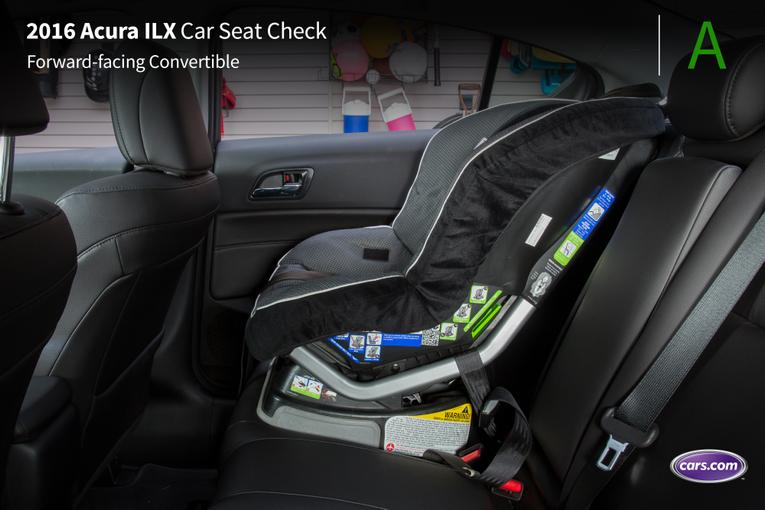
In an attempt to boost sales, Acura tweaked its 2016 ILX compact sedan with some light restyling. The ILX is based on the popular Honda Civic sedan, so that means the two cars have the same interior space, right? Wrong. The ILX has 34 inches of rear legroom, but the Civic has a bit more with 36.2 inches. Those 2.2 inches are critical when it comes to installing child-safety seats.
How many car seats fit in the second row? Two
What We Like
- The ILX's Latch system is easy to use with two sets of lower anchors in the outboard seats. They sit in the seat bight, where the back and bottom cushions meet, but the cushions easily move out of the way for good access. Three tether anchors sit under hinged plastic covers on the sedan's rear shelf. We had no problems using them.
- The rear-facing convertible installed easily into the ILX, but we had to move the front passenger seat forward one click to fit the car seat. Our 5-foot-8 tester was able to sit comfortably in the front passenger seat.
- To install both the forward-facing convertible and the booster seat, we had to remove the rear head restraint. Both car seats then fit well in the ILX.
What We Don't
- To fit the rear-facing infant seat behind the front passenger seat, we had to move the seat forward a significant amount. We also adjusted the front passenger's seatback to a more upright position. Our tester was uncomfortable in this position with her knees pushed against the glove box.
- The rear seat belt buckles are on floppy bases and sit snugly against the side of the booster seat. They will likely be difficult for young kids to use on their own.





Grading Scale
A: Plenty of room for the car seat and the child; doesn't impact driver or front-passenger legroom. Easy to find and connect to Latch and tether anchors. No fit issues involving head restraint or seat contouring. Easy access to the third row.
B: Plenty of room. One fit or connection issue. Some problems accessing third row when available.
C: Marginal room. Two fit or connection issues. Difficult to access third row when available.
D: Insufficient room. Two or more fit or connection issues.
F: Does not fit or is unsafe.
About Cars.com's Car Seat Checks
Editors Jennifer Geiger and Jennifer Newman are certified child-safety seat installation technicians.
For the Car Seat Check, we use a Graco SnugRide Classic Connect 30 infant-safety seat, a Britax Marathon convertible seat and Graco TurboBooster seat. The front seats are adjusted for a 6-foot driver and a 5-foot-8 passenger. The three child seats are installed in the second row. The booster seat sits behind the driver's seat, and the infant and convertible seats are installed behind the front passenger seat.
We also install the forward-facing convertible in the second row's middle seat with the booster and infant seat in the outboard seats to see if three car seats will fit; a child sitting in the booster seat must be able to reach the seat belt buckle. If there's a third row, we install the booster seat and a forward-facing convertible. To learn more about how we conduct our Car Seat Checks, go here.
Parents should also remember that they can use the Latch system or a seat belt to install a car seat, and that Latch anchors have a weight limit of 65 pounds, including the weight of the child and the weight of the seat itself.
No comments:
Post a Comment